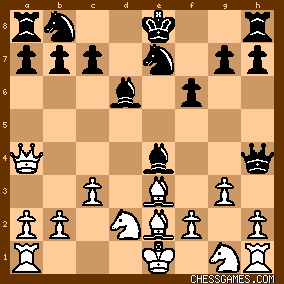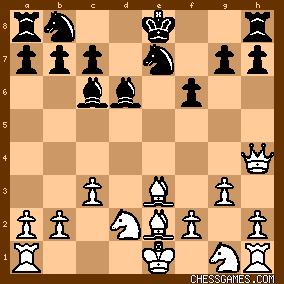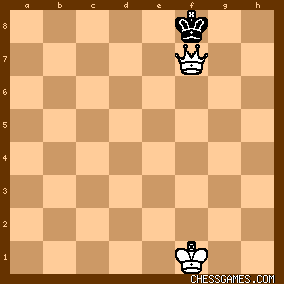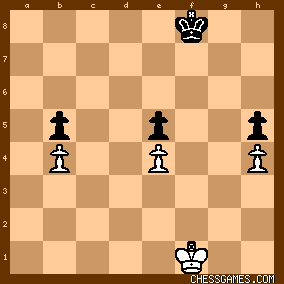|
< Earlier Kibitzing · PAGE 5 OF 5 ·
Later Kibitzing> |
| Jun-01-11 | | sevenseaman: <if an <en passant> capture is the only legal move it must be playerd. There is no longer an option, except to resign.> Thanks <Phony Benoni> Thats how it looked to me. The position occurred in a puzzle. Not only was the e.p. capture the only legal move it was the last as well. The capture resulted in self-mate. I said, 'What a foolish thing to do, he could have refused.' That he didn't must have been as per the rules. |
|
| Jun-01-11 | | Patriot: I chose 11.Ng5 with similar lines as <agb2002>. As he said, Ng1 did not occur to me. The only place I disagree is <The alternative 11.h3 seems to fail after 11... Qxg2 (12.Nh4 Qd5; 12.Rh2 Bxh2).> since 11.h3 Qxg2 12.Nh4 Qxh1+. |
|
| Jun-01-11 | | DarthStapler: I picked Ng5 Qh4 (Qxg2 Bf3) g3 Qh6 Nf7 |
|
| Jun-01-11 | | Patriot: I wondered what was wrong with 4.Qh5  -a very common idea. But black turns the tables: 4...g6 5.Nxg6 Qxe4+ 6.Be2 Qxg6 -a very common idea. But black turns the tables: 4...g6 5.Nxg6 Qxe4+ 6.Be2 Qxg6  (6.Qe2 Qxe2+ 7.Bxe2 hxg6 (6.Qe2 Qxe2+ 7.Bxe2 hxg6  ). This would be an easy trap to fall into! ). This would be an easy trap to fall into! |
|
| Jun-01-11 | | beenthere240: Great illustration of both the short- and long-term putridity of the 2...f6 (Damiano?) defense. |
|
| Jun-01-11 | | agb2002: <Patriot: I chose 11.Ng5 with similar lines as <agb2002>. As he said, Ng1 did not occur to me. The only place I disagree is <The alternative 11.h3 seems to fail after 11... Qxg2 (12.Nh4 Qd5; 12.Rh2 Bxh2).> since 11.h3 Qxg2 12.Nh4 Qxh1+.> You're right. It seems that the variations with the bishop on f3 persisted longer than they should. |
|
| Jun-01-11 | | lost in space: Haven't got it.
I checked Ne5, Ng5 and Nd4, all playable, all with advantage wihte, but none of the moves as good as Ng1! And Ng1 I missed completely |
|
| Jun-01-11 | | Marmot PFL: Not real simple, but one win is 11 Ng5 Qxg2 12 Bf3 Bg4 13 Bxg2 Bxd1 14 Rxd1 fg5 15 Bxb7. Didn't see the simple 11 Ng1 Qg6 12 Bh5, but if 11...Qxg2 12 Bf3 the lines are much the same as my line. |
|
| Jun-01-11 | | kevin86: A queen trap in two...white advances by retreating his knight to g1. |
|
Jun-01-11
 | | Jimfromprovidence: I went with Nd4; did not not see the two better alternatives. There's a nice finish to the text position if black decides to play on with 12...Be4. White follows with 13 Qa4+!. 
click for larger viewNote that if black tries to interpose a piece on c6 beside the bishop white wins a piece with Nxe4 and still has the queen trapped. And If black plays 13...Bc6, white simply plays 14 Qxh4. 
click for larger view |
|
Jun-01-11
 | | scormus: 11. Nd4, Ne5, Ng5, Nb1, ... anywhere except h4. I feel like an African lion who saw all those impala running every whch way and couldnt fix on the one to chase. Sure, 11. Nb1 would have tasted the best. The one I ate was a lame old buck ... meat was awful tough. |
|
Jun-01-11
 | | scormus: ... Ng1 of course. Hell, I think I really am dyslexic :( |
|
| Jun-01-11 | | jheiner: Half credit. The Q trap jumped out at me. The Pc3 is the giveaway, nicely helping to cover the entire 4th rank. I missed the text line. I had 11.Ne5 Qh4 12.g3 Qh3 13.Bf1 winning the Q for the B. |
|
Jun-01-11
 | | Phony Benoni: Before <Once> challenges me again, here are another couple of examples of Winning by Retreating. J Blake vs G A Hooke, 1891
Dzindzichashvili vs Zacharov, 1957
The first game is almost surely spurious, but too amusing to take out of the database. |
|
| Jun-01-11 | | MiCrooks: Actually, Ng5 is essentially just as good as Ng1...evaluations are slightly better for Ng1 but both leave you up a Q for a R with best play. In both cases Qxg2 is the best move. On other moves the best replies have not been talked about for White. For instance, with Ng5 Qh4 marginally best is Ndf3 instead of g3. Not that g3 doesn't work, but Nf3 turns out considerably better as you play through variations. So I would say both Ng5 and Ng1 were solutions with Nd4 enough inferior to disqualify it. Now if you didn't know how to follow up with your move then all bets are off :)! |
|
| Jun-01-11 | | Once: <sevenseaman: if an <en passant> capture is the only legal move it must be played. There is no longer an option, except to resign.> With just one exception, I think. If an en passant capture is the only legal move <and> it leads to an inevitable draw then I think it cannot be played. The laws state that a game is drawn immediately if a position arises that cannot be won by either side by any combination of moves. Mind you, I can't think of a position where a forced ep leads to a forced draw, so maybe this is just hypothetical! |
|
| Jun-01-11 | | Once: <Catfriend: ... I fail to see why 11. Ng1 Qxg2 12. Bf3 is <prettier> (forget stronger) than 11. Ng5 Qxg2 12. Bf3> I guess that prettiness is in the eye of the beholder... 11. Ng1 appeals to me because it wins by sending the knight back to its starting square. Despite everything that we read about developing pieces onto aggressive squares, this puzzle is solved by a backwards un-developing move. It's like winning a battle by taking your clothes off. |
|
| Jun-01-11 | | David2009: J Krejcik vs Munz, 1911 White 11? Black has been playing with fire and now gets his fingers burnt: 11 Ng5 and now
(A) 11...Qxg2 12 Bf3 Qxh1+ 13 Bxh1 and if 13...fxg5 14 Bxb7;
(B) 11...Qh4 12 g3 Qxg5 13 Bxg5 fxg5 14 Bf3 should win on material. If 12...Qh6 13 Nf7 Qh3 and White can choose between
14 Nxh8 and 14 Bf1 harassing the Q further but there's no need to decide this when playing 11 Ng5. Time to
check:
====
Puzzle position 
click for larger view
White plays 11 Ng1! even better. Have I messed up? Crafty End Game Trainer link: http://www.chessvideos.tv/endgame-t...
11 Ng5 wins but I had missed Black's best defence 11...Qxg2 12 Bf3 Bg4! as pointed out by other kibitzers and which limits Black's losses to a piece for a Pawn. The EGT defends the resulting lost position tenaciously and I won third time round (blundering badly the first two times). 11 Ng1! is hard to see because it undevelops. I have the consolation of missing the best move in excellent kibitzing company. |
|
| Jun-01-11 | | mito1985: What happens in the 11 Ng5 line when ..Qxg2 12 Bf3 Bg4? I cant get and answer to that |
|
| Jun-01-11 | | Patriot: <mito1985> <What happens in the 11 Ng5 line when ..Qxg2 12 Bf3 Bg4?
I cant get and answer to that>
This was answered in several posts. Here's one answer: <<Marmot PFL>: Not real simple, but one win is 11 Ng5 Qxg2 12 Bf3 Bg4 13 Bxg2 Bxd1 14 Rxd1 fg5 15 Bxb7.> |
|
Jun-01-11
 | | Phony Benoni: <Once> I'm not sure about your interpretation of the rules in that case. For example, take this position with White to play:
click for larger viewWhite plays <1.g4+>. Black's only legal move is <1...fxg3>, but that produces "an inevitable draw" by stalemate. Are you saying the move cannot be played, and therefore White wins by checkmate? (And before someone asks, the position is legal.) However, I'm sure you're actually talking about a draw by lack of mating material. In that case, I don't think there is such a position. After an <en passant> capture at least one pawn remains on the board, and that's always mating material. But perhaps this is the time to recount The Great <En Passant> Swindle. Our position is from a game at the 1977 US Open between the charitably named NN (White, rated 1011) and Sneaky Pete (Black, rated 1209). No, not the chessgames.com kibitzer, but a computer--and remember, this is a 1977 model computer. In true puzzle fashion, it's <61...?> 
click for larger viewBlack is lost. As much as he would love to play 61...b5#, White has this forced <en passant> capture in reply, when his king will easily escape and Black's bishop will soon go lost. But Sneaky Pete came up with the brilliant <61...b6!!>. Of course, White could just enter the winning line with 62.cxb6, but it isn't forced and he has a chance to blunder. And sure enough, White cooperated: <62.Nxc6?? b5+ 63.Ka5 Ra3#!> Now tell me, would Rybka or Houdini have thought of that one? |
|
| Jun-01-11 | | wals: 2...f6. not in first five. -5.
8.c3.. not in first five. -5.
8...Bd6.not in first five. -5.
9.Be3. 4th best. -3.
10...Qg4.5th best. -4.
11...Qh4.5th best. -4.
No. 1 candidate move = 0.
Deviations from that = 1 penalty point per rated level.
maximum 5.
Black 18, White 8, and a win for white, Black resigning after 12.g3, +7.09. courtesy Rybka 4 x 64. |
|
| Jun-01-11 | | stst: It actually looks difficult at first sight, as attacking the W K seems an event quite a long way to go.
A lesser aim, with the peculiar position of the Bk Q, would be to trap her.
Try
11.Nd4 (eying e6 on next, but actually "checking/trapping" the Q)
Bk Q has no good place to go:
IF: 11....Qxg2, 12.Bf3 Q flees, 13.Bxb7 and the R@a8 is lost
IF: 11....Qxh1, 12.BxQ
IF: 11....Qh4, 12.g3 Qh3, 13.Bf1 Q is lost.
That would be enough a grill for Bk. |
|
| Jun-02-11 | | Once: <Phony Benoni> The law I am thinking about is 9.6 which says: <9.6 The game is drawn when a position is reached from which a checkmate cannot occur by any possible series of legal moves. This immediately ends the game, provided that the move producing this position was legal.> This is the law which produces the draw by insufficient material. But we had a discussion a few months ago about other situations when this law kicks in. Take this silly position: 
click for larger viewIn a desperate time scramble White has just played Qf7+. Black's flag falls before he can play Kxf7 to get a draw by insufficient material. Does black lose on time? When we talked about this before we didn't think so. Rule 9.6 says that the game is drawn immediately that a position is reached where checkmate cannot happen by any legal series of moves. In this position, black has to play Kxf7 leading to an inevitable draw. This means that he cannot play Kxf7 because the game is already drawn. The proper sequence of events would be 1. Qf7+ draw. Note that this law is not triggered by either playing claiming the draw. It is absolute. It also has to be any possible series of legal moves, not best play. The law also kicks in in stalemate positions or positions where neither side can make progress, like this one: 
click for larger viewThis position is a draw the instant that the pawns are locked because there is no way for either king to get across the board. So the situation we wanted was one where one player has to play an en passant capture and his opponent is not allowed to recapture because rule 9.6 has kicked in. And your diagram does this perfectly. White plays 1. g4+ and the game is immediately drawn. We have produced a position which cannot be won by an series of legal moves. Black does not have to play fxg (ep) draw. And a strict interpretation of 9.6 is that he cannot play this. The game was drawn as soon as white played g4+. I would be gobsmacked if you managed to find a real game where this happened! |
|
| Jan-22-14 | | Karpova: I found the date May 7, 1911, in the short column on the Damiano, page 179 of the May-June 1912 'Wiener Schachzeitung'. But where is this strange round information from and what does it mean - <.113>? It was already there and I left it untouched, but it should probably be deleted. The 'Wiener Schachzeitung' gives only date and location (Vienna), no event. This may not have been a tournament/match game, but an informal game. |
|
 |
 |
|
< Earlier Kibitzing · PAGE 5 OF 5 ·
Later Kibitzing> |





